|
|
|
Sort Order |
|
|
|
Items / Page
|
|
|
|
|
|
|
| Srl | Item |
| 1 |
ID:
133061
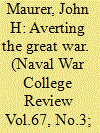

|
|
|
|
|
| Publication |
2014.
|
| Summary/Abstract |
Winston Churchill is best remembered as a valiant leader in times of war. He should also be remembered, however, for his efforts to prevent the catastrophic great wars that would scar the history of the twentieth century. While it is largely forgotten today, on the eve of the First World War Churchill made a remarkable attempt to halt the head-to-head competition in naval armaments that was setting Great Britain and Germany against one another as adversaries. In a bold and unconventional initiative, Churchill invited Germany's rulers to take a "holiday" from the competitive building of battleships. As the civilian head of Britain's Royal Navy, Churchill made public appeals for a naval holiday on three separate occasions before 1914. Behind the scenes too he pressed for the opening of negotiations with Germany, using the holiday proposal as the starting point for discussions. It was Churchill's earnest hope that the naval holiday would stop the action-reaction dynamic of the arms race-what statesmen of that era called "the sea war waged in the dockyards"-and reduce the antagonism between Britain and Germany. Rather than letting Britain and Germany be arrayed in opposing camps, he wanted to promote cooperation between Europe's two leading great powers.
|
|
|
|
|
|
|
|
|
|
|
|
|
|
|
|
| 2 |
ID:
133060
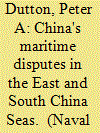

|
|
|
|
|
| Publication |
2014.
|
| Summary/Abstract |
China pursues its security through interior strategies that involve the development of rings of security around central areas of national interest. The Chinese have long felt vulnerable from the sea, and their current maritime strategy seeks to reduce that vulnerability by extending a ring of maritime control around China's periphery. China pursues this control through a combination of forcestructure development and legal assertions. Tensions arise because China's strategy conflicts with the territorial claims, resource interests, and security concerns of other states in East Asia. China's strategy also causes friction with the United States, which relies on freedom of navigation in maritime East Asia for American security interests and which must reassure regional allies and partners that American security guarantees are meaningful. In order to ensure the position of the United States in East Asia, American policies must focus on maintaining the region as an open, maritime system. This requires continuous development of technological advantages to ensure that the center of power in Asia does not migrate from the maritime domain to the continent. It also requires the United States to support the ability of allies, friends, and partners to resist China's nonmilitarized coercion, as well as to reinforce the normative structure that supports the efficacy of maritime power in the region and around the globe.
|
|
|
|
|
|
|
|
|
|
|
|
|
|
|
|
| 3 |
ID:
133067
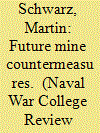

|
|
|
|
|
| Publication |
2014.
|
| Summary/Abstract |
Admiral Smith's point might be as valid today as it was sixty-four years ago. It refers to mines that he faced off the coast of Korea. Naval (or sea) mines are, by themselves or in combination with other weapons, a promising choice to parties pursuing antiaccess/area-denial objectives. The number of mines in the stocks of countries around the world and the ease of laying them mean that sea control is very likely to be lost again in future tension and conflict. This article is an attempt to describe the means, and to some extent the methods, under consideration to win it back if the need arises again. Mines pose a threat not only to military use of the sea but also to civilian shipping. The global economy depends on secure access to the global commons. With roughly 95 percent of world trade being shipped by sea, it is clear how much the economy depends on open trade routes and sea areas.1 Therefore, the capability to counter mine threats is needed to provide freedom of movement not only to one's own and friendly naval forces but to merchant shipping as well.
|
|
|
|
|
|
|
|
|
|
|
|
|
|
|
|
| 4 |
ID:
133062
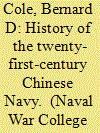

|
|
|
|
|
| Publication |
2014.
|
| Summary/Abstract |
China historically has been a continental rather than a maritime power, despite its more than eleven thousand miles of coastline and more than six thousand islands. It has more often viewed the sea as a potential invasion route for foreign aggressors rather than as a medium for achieving national goals, a tendency that has contributed to the weakness of the Chinese maritime tradition. This attitude had changed by the beginning of the twenty-first century. The remarkable growth of China's economy beginning in the last two decades of the twentieth century, the broadening of Beijing's global political and economic interests, and resolution of almost all border disputes with its many contiguous neighbors have contributed to increased attention to threats to the vital sea lines of communication (SLO Cs) on which China increasingly depends.
|
|
|
|
|
|
|
|
|
|
|
|
|
|
|
|
| 5 |
ID:
133064


|
|
|
|
|
| Publication |
2014.
|
| Summary/Abstract |
he shift of naval focus toward the littoral arena that has resulted from the dramatic changes in the geostrategic environment reflects a major rethinking of the role and objectives of sea power in the foreseeable future.1 Clearly these fundamental changes will result in an adjustment of the relative weight of "green water" and "brown water" missions on one hand and the high seas, which have been dominant in naval strategic thinking throughout this century, on the other. This article raises the question, however, of whether the process of transformation is taking fully into account the scope of the adjustment, particularly theimplications it has for prevailing concepts of ship design.
|
|
|
|
|
|
|
|
|
|
|
|
|
|
|
|
| 6 |
ID:
133065
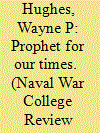

|
|
|
|
|
| Publication |
2014.
|
| Summary/Abstract |
It is appropriate for the Naval War College Review to reprint the superb essay by Admiral Ya'ari, because
the things he foresaw nearly twenty years ago are all coming to pass-an analytical performance worthy of any Old Testament prophet. The growing hazards and deadliness of the littoral seas are something all navies must take into account, but particularly the U.S. Navy, because it is only just beginning to grasp the uniqueness of the littoral environment, the need for new tactics, and the value of warships better suited to fight in its clutter. For example, with Professor Don Brutzman of the Naval Postgraduate School, I have reached the conclusion that the goal of "networkcentric warfare" (NCW) is appropriate only for operating an aircraft carrier battle group, an expeditionary strike group, or a surface action group, none of which can perform its function without radiating almost continuously. But NCW is ill suited for more numerous, distributable, smaller, and less expensive ships intended to fight in the demanding environment described by Admiral Ya'ari.
|
|
|
|
|
|
|
|
|
|
|
|
|
|
|
|
| 7 |
ID:
133066
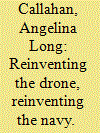

|
|
|
|
|
| Publication |
2014.
|
| Summary/Abstract |
Invention is often perceived as an isolated event, attributable to a momentous "first" or to a single, patent-holding inventor. However, rather than questioning what qualified as the first drone aircraft or to whom the title as its "inventor" belongs, this article maps out the winding uncertainties of technical evolution- exploring how seemingly failed projects laid groundwork for the U.S. Navy's first successful radio-controlled drone aircraft. Situated as they are among a cluster of interwar emerging technologies, drones provide an instructive case study through which to consider how the U.S. Navy's research-and-development (R&D) communities function as a strategic asset. When the availability of one subcomponent can jeopardize an entire research project, such factors as institutional stability, the circulation of ideas, and willingness to reevaluate naval doctrine become critical to national security. So too does the ability of experts to recognize a (perhaps temporary) dead end when they face one. This article will flesh out, for this case, the actors and activities of innovation, emphasizing how the collaborative nature of this work can mitigate the uncertainties
and risks of R&D.
|
|
|
|
|
|
|
|
|
|
|
|
|
|
|
|
| 8 |
ID:
133063
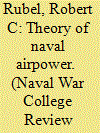

|
|
|
|
|
| Publication |
2014.
|
| Summary/Abstract |
The U.S. Navy has never been comfortable with theory or doctrine at what is now known as the operational level of war. The Navy has always possessed robust ship- and formation-level doctrine-tactics-and of course has embraced the high-level sea-power theories of both Alfred Thayer Mahan and Julian Corbett. The gap in the middle either has not been needed-as has been essentially the case for most of the Navy's history except for World War II-or has been filled by adaptive practice in the form of specific campaign or operations plans. For the Navy, the old framework of strategy and tactics has sufficed since 1945. However, an emergent set of circumstances in the form of Chinese naval development, as well as a new generation of weapons and sensors, is driving the Navy into incorporating the operational level into its culture. Moreover, this development is bringing the Navy into competition, or perhaps conflict, with the U.S. Air Force over which should exert operational control of aviation over the water. Whereas this task was always presumed to be the preserve of the Navy, the establishment in Hawaii of a regional Air Operations Center (AO C) that
in theory controls all air in the theater will challenge Navy assumptions and equities. The tactics of interservice squabbling aside, the Navy will need a theory of naval airpower as a foundation for its arguments to preserve operational control of its aviation.
|
|
|
|
|
|
|
|
|
|
|
|
|
|
|
|
|
|
|
|
|